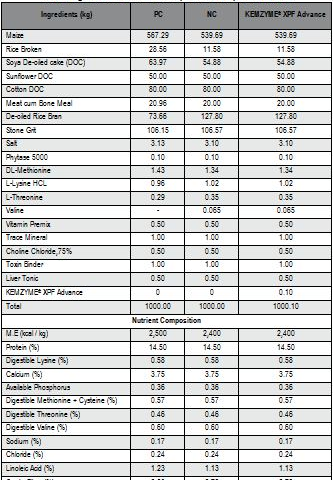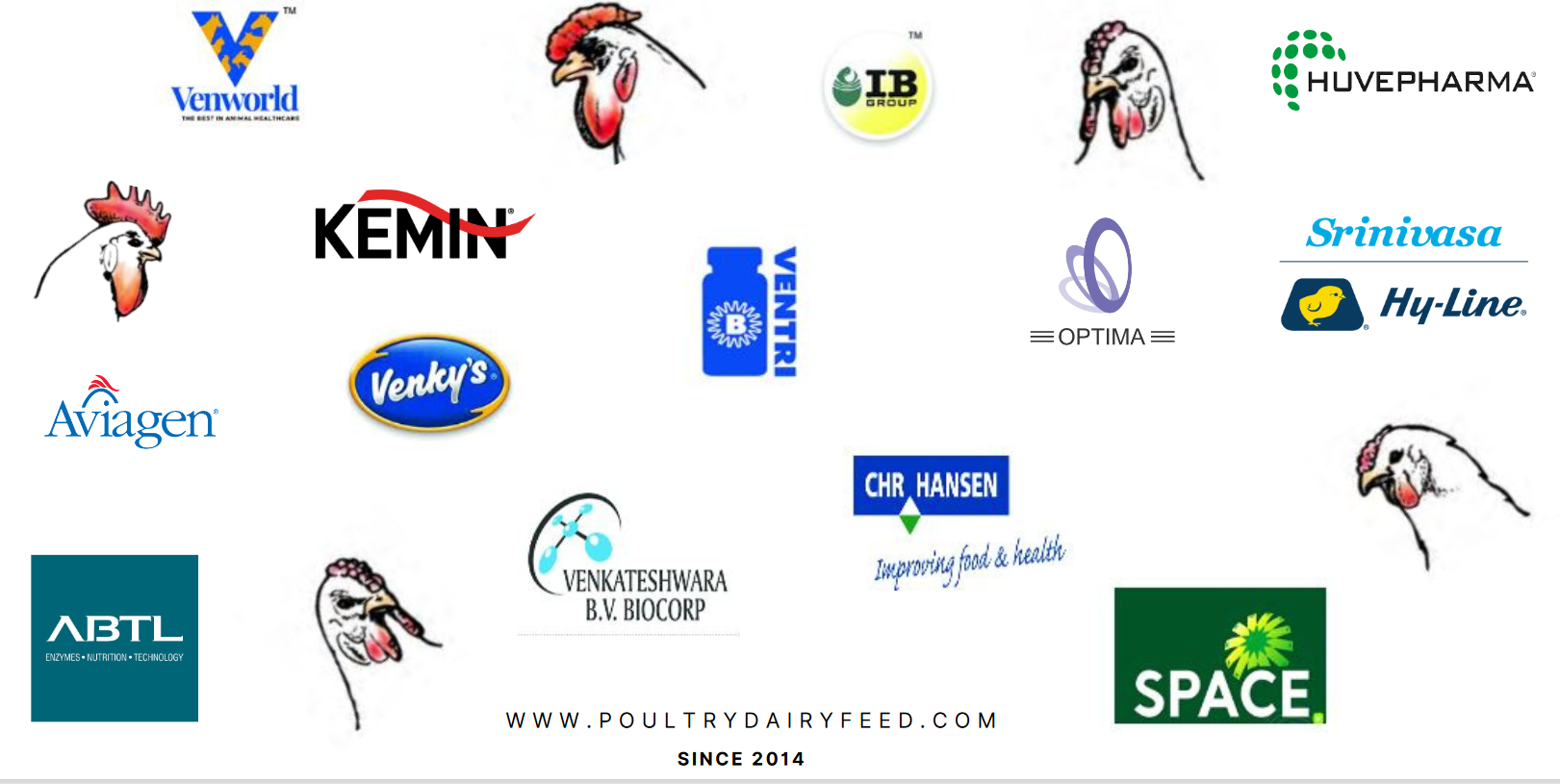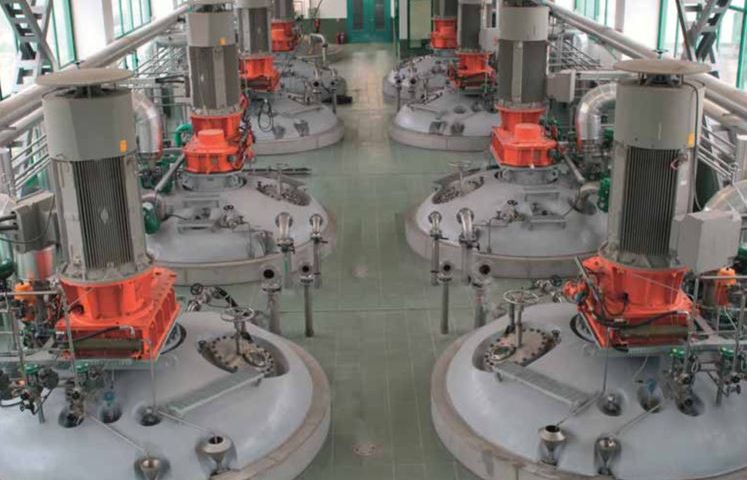Identifying high-quality digestible ingredients for diet formulation is a vital task in domestic poultry industry. As some nutrients in animal feed cannot be digested fully by animal digestive enzymes, quantum of essential nutrients will not be available to the animal. Digestible corn and soybean meal often contain high molecular weight soluble non-starch polysaccharides (NSP), and a complex chemical structure hinders the normal digestion and absorption of nutrients in the gastrointestinal tract (GIT). For hens fed with a typical corn-soy ration, approximately 400-450 kcal of energy per kg of diet is undigested. Inclusion of exogenous enzymes to poultry feed is one of the successful ways to solve this issue. Exogenous enzymes are either used to correct the lack of specific endogenous enzymes in various feedstuffs to digest certain nutrients or to hydrolyze antinutritional factors in feed ingredients. Hence, exogenous enzymes in diet improve nutrient utilization and absorption in GIT.
KEMZYME® XPF Advance is an unique combination of carbohydrase, ferulic acid esterase for better breakdown of arabinoxylans, and a multi protease that has novel and patented concepts of xylanase potentiating factor (XPF) and slow-release amylase (SRA). It enhances the action of endogenous enzymes secreted in gastrointestinal tract and improve the efficacy of nutrient utilization by degradation of structural non-starch polysaccharides.
ARABINOXYLAN AND FERULOYL ESTERASE (FAE)
Among the non-starch polysaccharides, arabinoxylan is a major NSP which accounts about 40% of NSPs. Branching structure of arabinoxylan throws challenge on the efficacy of xylanase due to the phenolic side chain (Figure 1). Among the commonly used grains, corn has relatively complex branched chains followed by bajra and wheat. In case of protein meals, along with arabinoxylans, other components like pectin, mannans, and oligosaccharides demand comprehensive enzyme approach for improving nutrient utilization.
Esterified (di)ferulic acids play an important role in digestibility of NSPs by influencing the chemical structure of this component. Feruloyl esterase (FAE) catalyzes the cleavage of these ester bonds (Figure 2), helping the main chain hydrolases in degrading the plant cell wall. Addition of these side chain breaking enzymes such as ferulic acid esterase could enhance the activity of xylanase thus enhancing the animal performance.

Figure 1: Schematic representation of Arabinoxylan Structure (https://www.kemin.com/in/en/products/kemzyme-xpf).

Figure 2: Feruloyl esterase cleaves ester bonds of (di)ferulic acids, helping in the digestibility of non-starch polysaccharides.
XYLANASE POTENTIATING FACTOR (XPF)
XPF cleaves the branching structure of arabinoxylans and enhances the access to xylanase and other NSPs (Figure 3). Breakdown of arabinoxylan side chains enhances prebiotic potential of xylo-oligosaccharides (XOS), reduces viscosity, supports gut integrity, thus enhancing the nutrient utilization and animal performance.

Figure 3: Breakdown of Arabinoxylans with Xylanase, and Xylanase in combination with Debranching Enzyme (Image courtesy: J.Agric. Food Chem., 2016).
SUSTAINED RELEASE AMYLASE (SRA)
Improving starch digestion beyond duodenum enhances the energy utilization of carbohydrates. This minimizes the energy loss and gluconeogenesis which enhances the nutrient uptake and productive performance. Normal amylase cannot reach small intestine due to acidity of proventriculus and gizzard. Slow release amylase overcome this limitation by coating amylase core with gastric stability coatings. SRA technology enables the release of amylase in targeted site in small intestine (Figure 4).

Figure 4: Sustained Release Amylase (SRA) – Sustained Starch Digestion.
OBJECTIVE
This experiment was aimed to evaluate the effect of a multienzyme product (KEMZYME® XPF Advance) supplementation on performance parameters (egg production, feed intake, egg weight, egg mass, feed conversion per egg, and feed conversion for egg mass) and economic returns in laying hens at 29 to 36 weeks of age.
MATERIALS AND METHODS
The experiment was conducted at a customer experimental egg-laying farm facility in Telangana, India. A random allocation of a total of two thousand and seven hundred 29-wk-old Lohmann variety laying hens to three dietary treatments, and each treatment had nine replicates with 100-layer hens per replicate. The experimental treatments used were (Table 1): a positive control (PC) diet formulated to attend laying hens nutrient requirement according to the recommendations of Lohmann manual; a negative control (NC) diet calculated with a reduction of 100 kcal/kg metabolizable energy (ME) of diet; and a treatment group that had an enzyme complex, KEMZYME® XPF Advance, was added on top at a dose of 100 gram per metric ton of feed corresponded to NC diet plus “on top” enzyme addition. Table 2 represents the ingredients used and nutritional composition of the experimental diets.
The experiment was divided into two periods of 28 days each to collect data and calculate the variables of performance. Productive characteristics evaluated were feed intake (g), egg production (%), feed conversion per egg, egg weight (g), egg mass (g), and feed conversion for egg mass (g). Feed consumption per replicate was recorded periodically and used to calculate daily feed intake per hen. Feed conversion per egg was calculated through the ratio between feed intake and egg production. Eggs were collected twice a day (morning and afternoon), weighed, and used to calculate the egg mass (egg production in percent by egg weight in grams). Feed conversion for egg mass was calculated through the ratio between feed intake and egg mass produced. Laying hens were housed in California cages with an open house system under the same managerial and hygienic conditions throughout the experiment. Hens fed in morning and afternoon with feed and water provided ad libitum basis. All experimental protocols were followed by customer, technical, and R&D team based on their standard protocol.


STATISTICAL ANALYSIS
Statistical analysis was performed using Stat graphics Centurion XVI.II software (version 16.2.04). Data analyzed by one-way ANOVA. P value of P≥0.05 was considered statistically non-significant.
RESULTS
Table 3 represents the observations regarding the zootechnical performance index of layers in all three treatment groups. There was no significance(P≥0.05) between the treatments regarding the variables of performance in hens fed the positive control diet and those fed a diet of low nutritional density, with the addition of KEMZYME® XPF Advance or without the addition of enzymes (NC) (Table 3). However, numerically, the hens supplemented with KEMZYME® XPF Advance noted a slight increase in egg production rate, egg mass along with improved feed intake, and feed conversion when compared to NC.
Hens fed the diet with reduced nutrient levels (NC) presented the worst performance. Lowest rate of egg-laying shown by the negative control (NC) (90.79 %), with reduction of nutritional levels illustrate the impact of reduced levels in metabolizable energy than the hens supplemented with KEMZYME® XPF Advance (92.75 %) and PC diet (93.82 %). There were no significant differences (P≥0.05) in feed intake among the treatments. Positive control (PC) hens had the highest feed intake of 113.54 g per bird, followed by KEMZYME® XPF Advance with 110.88 g and NC with 110.54 g of feed intake per bird. As a result, KEMZYME® XPF Advance treated hens resulted in better feed conversion per egg by consuming less feed of 2.66 g and 1.26 g per egg than the NC and PC diet, respectively. KEMZYME® XPF Advance addition to NC diet did not affect (P≥0.05) egg mass and egg weight between the treatments. Considering the whole experiment, hens received a low energy density diet without the addition of enzymes displayed less egg mass of 1.36 g than those with the addition of KEMZYME® XPF Advance. As per the economic benefits, addition of KEMZYME® XPF Advance in an energy-reduced diet of 100 Kcal per kg delivered a return on investment (ROI) of 6:1 and 4:1 when compared to PC and NC groups, respectively (Table 4).

Note- PC- Positive Control; NC- Negative Control; SD: Standard Deviation; SEM: Standard error mean; C.V. (%): Coefficient of variance; No significant differences (P≥0.05) were detected among treatments for all traits.

DISCUSSION
On-top application of KEMZYME® XPF Advance in an energy-deficient diet performed better than negative control in terms of egg production, egg mass, feed conversion per egg, and feed conversion for egg mass. It closely related to the results found for hens with PC diets. Results indicated that KEMZYME® XPF Advance improved the overall performance of laying hens. Also, supplementing exogenous enzymes promoted better nutrient digestion and utilization, reducedthe moisture in excreta, and eliminated partial or complete anti-nutritional factors found in dietary feeds commonly used in poultry farming. Decrease in energy losses due to caloric increment and volatile fatty acids in excreta (as a result of inefficient microbial fermentation product) attribute to the improvement in digestibility and nutrient utilization through ME reduction in the diet supplemented with exogenous enzymes. Studies demonstrated similar results with KEMZYME® XPF Advance for feed intake and conversion. Gentilini et. al., (2009) and Resende et. al., (2017) reported a non-significant difference in performance variables due to the on-top addition of enzyme complex to basal diet and low nutritional density diet. But numerically, higher performance than negative control and positive control diet suggest that enzymes improved the energy value of diets. Reduction in metabolizable energy levels and inclusion of KEMZYME® XPF Advance did not influence egg weight. It had a positive effect on production, which was reflected in the values for egg mass. This shows that hens are more efficient at converting feed into a product (eggs) and eventually grow. Despite an increase in egg production of positive control group, the net profitability of positive control did not increase due to the increase in feed cost per egg (due to high feed intake) throughout the period.
CONCLUSION To conclude, commercial enzyme supplementation containing KEMZYME® XPF Advance was effective to compensate the negative impact of lower energy levels and improve the productive performance of layer hens. Performance indicators that changed because of KEMZYME® XPF Advance supplementation was egg production, feed intake per bird, feed conversion per egg, and feed conversion for egg mass. The results were similar to positive control, which prove the efficiency of enzyme supplementation. Thus, KEMZYME® XPF Advance usage to low-energy layer diets could be an effective feeding strategy to enhance nutrient digestion, which ultimately improve the perform





